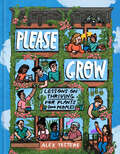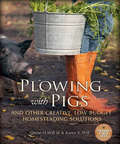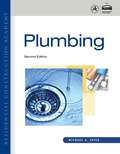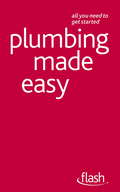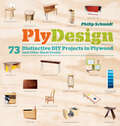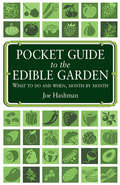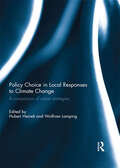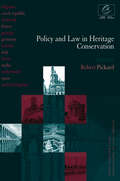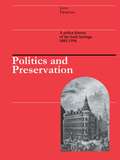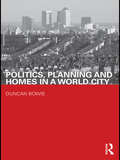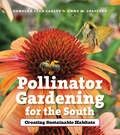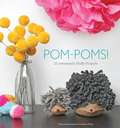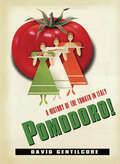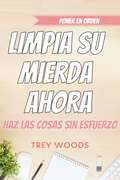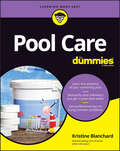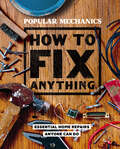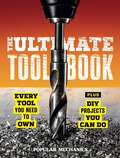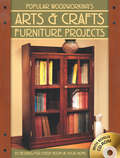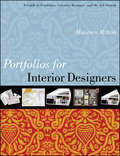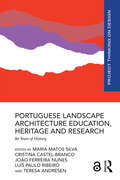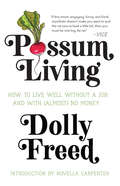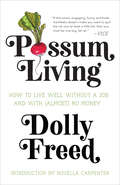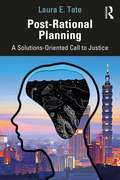- Table View
- List View
Please Grow: Lessons on Thriving for Plants (and People)
by Alex TestereDiscover the life lessons plants can teach you—from the importance of putting down roots to leaning on others for support and nourishment—in this charming, illustrated guide to personal growth.Every idea, relationship, or project begins with a seed: A seed of creativity, a flicker of hope, an inkling of motivation. In Please Grow, illustrator Alex Testere takes us on a journey through the life of a well-tended plant or garden—from nourishing a seed to propagating, protecting, pruning, and beyond—relating the lessons we can learn from the natural world to our everyday lives, including:Planting a seed is only the beginning.A flower is a reminder of what is possible when the right circumstances align.Extending your roots is like building community--both are lifelines.Compost old ideas and experiences to create fuel for a fresh start.Nothing lasts forever--and in some cases, that can be a good thing.With sweet, vibrant art, ecological sidebars, and a sprinkling of practical plant care tips, Please Grow is a gentle reminder of life's cyclical, ever-blossoming nature. We all have the power to plant our own seeds and harvest our own blooms. So, what are you waiting for?
Plowing with Pigs and Other Creative, Low-Budget Homesteading Solutions
by Karen K. Will Oscar H. WillFueled by a failing economy and a passionate desire for a return to simpler times, a new wave of homesteaders is seeking the good life and the kind of true satisfaction that can only be built, not bought. Many of these modern pioneers are cash poor, but rich in energy and creativity. Plowing with Pigs and Other Creative, Low-Budget Homesteading Solutions offers them a set of fresh ideas for achieving independence through sweat equity and the use of unconventional resources. This highly readable and entertaining guide brings together answers to common problems faced by homesteaders young and old, urban, suburban, and rural. Traditional knowledge is combined with MacGyver-style ingenuity to create projects that maximize available resources, including: Animal management strategies for the yard, garden, and field Pole building and construction techniques from woodlot materials Replacing farm machinery with homemade hand tools and implements Leveraging increased self-sufficiency into a home-based business Whether you are a dreamer or a doer, Plowing with Pigs will inspire, challenge, and enable you to do more with less (and have fun doing it). Oscar H. (Hank) Will III is a farmer, scientist, and author, known for seeking and implementing creative farmstead solutions. The editor of Grit magazine, Hank has published hundreds of articles and five books on a range of topics including antique farm machinery. Karen K. Will is editor of The Heirloom Gardener magazine and author of Cooking with Heirlooms: Seasonal Recipes with Heritage-Variety Vegetables and Fruits. She operates Prairie Turnip Farm with her husband Oscar H. Will III.
Plumbing
by Michael A. JoyceRESIDENTIAL CONSTRUCTION ACADEMY: PLUMBING, 2E is the ideal book to create a direct link between readers' education/training program and the residential construction industry. The result of a strategic partnership between the National Association of Home Builder's (NAHB) Home Builders Institute and Delmar, Cengage Learning, the Residential Construction Academy Series is the perfect way to learn essential workplace skills for readers new to the building trades. Written in partnership with the Home Builders Institute, and endorsed by NAHB, RESIDENTIAL CONSTRUCTION ACADEMY: PLUMBING, 2E provides a step-by-step approach to residential plumbing installations based on national skill standards. Focusing on "Green" advancement in the plumbing trades, this book thoroughly explains the process of installing residential plumbing systems by exploring topics such as tools of the trade and proper safety measures and by offering various tips to increase readers' on-the-job productivity. Logically organized to build a foundation of knowledge, this book progresses from the installation of common fixtures to troubleshooting techniques that will aid readers. An emphasis on creative layout and the importance of understanding code variations will foster readers' understanding of plumbing system installation that is based on typical situations as well as unique jobsite conditions.
Plumbing Made Easy: Flash
by Roy TreloarThe books in this bite-sized new series contain no complicated techniques or tricky materials, making them ideal for the busy, the time-pressured or the merely curious. Plumbing Made Easy is a short, simple and easy to follow guide to mastering some simple plumbing jobs that might occur on an everyday basis. By learning some basic skills and techniques you can learn how to carry out repairs and simple projects - in just 96 pages. Ideal for the busy or the thrifty, Plumbing Made Easy is a quick, to-the-point guide for those who want to complete simple plumbing jobs quickest time possible.
Plumbing Made Easy: Flash
by Roy TreloarThe books in this bite-sized new series contain no complicated techniques or tricky materials, making them ideal for the busy, the time-pressured or the merely curious. Plumbing Made Easy is a short, simple and easy to follow guide to mastering some simple plumbing jobs that might occur on an everyday basis. By learning some basic skills and techniques you can learn how to carry out repairs and simple projects - in just 96 pages. Ideal for the busy or the thrifty, Plumbing Made Easy is a quick, to-the-point guide for those who want to complete simple plumbing jobs quickest time possible.
PlyDesign: 73 Distinctive DIY Projects in Plywood (and other sheet goods)
by Philip SchmidtMake sleek and functional home furnishings from inexpensive plywood and other off-the-shelf materials using only basic hand and power tools. This unique building guide offers 73 innovative ideas for using plywood to make everything from desks and workstations to children’s playhouses. Projects for every need and skill level are presented with clear assembly diagrams, step-by-step instructions, and photos of the finished product. Discover the simplistic beauty plywood can bring to your next project and take pride in making your own handmade furniture.
Pocket Guide To The Edible Garden: What To Do And When, Month By Month
by Joe HashmanThe Pocket Guide to the Edible Garden takes its readers through the fruit and vegetable gardening year, listing month-by-month the tasks to be done and showing in original hand-drawn illustrations exactly how to do them. It answers those awkward but essential questions regarding how deep, how far apart, how to tend and care, and how - and when - to do this and that. This handy book is a practical manual that wants to spend most of its life in your pocket or in the garden shed, and to be consulted regularly throughout the seasons, just as you might turn to an experienced old friend for guidance and advice on edible gardening matters. The Pocket Guide to the Edible Garden holds in its pages the knowledge and the experience of author Joe Hashman (aka 'Dirty Nails' of the Blackmore Vale Magazine) condensed into clear, concise language and amplified by Helen Lanchbery's meticulous drawings.Contents: Background; Introduction; How to use this book; Understanding proprietary growing media; Green manures; JANUARY; General jobs to do; Leaves & greens; Roots, tubers and stems; Veg fruit; Onion tribe; Peas & beans; Edible flowers; Fruit garden; FEBRUARY; General jobs to do; Leaves & greens; Roots, tubers and stems; Veg fruit; Onion tribe; Peas & beans; Edible flowers; Fruit garden; MARCH; General jobs to do; Leaves & greens; Roots, tubers and stems; Veg fruit; Onion tribe; Peas & beans; Edible flowers; Fruit garden; APRIL; General jobs to do; Leaves & greens; Roots, tubers and stems; Veg fruit; Onion tribe; Peas & beans; Edible flowers; Cereals; Fruit garden; MAY; General jobs to do; Leaves & greens; Roots, tubers and stems; Veg fruit; Onion tribe; Peas & beans; Edible flowers; Cereals; Fruit garden; JUNE; General jobs to do; Leaves & greens; Roots, tubers and stems; Veg fruit; Onion tribe; Peas & beans; Edible flowers; Cereals; Fruit garden; JULY; General jobs to do; Leaves & greens; Roots, tubers and stems; Veg fruit; Onion tribe; Peas & beans; Edible flowers; Cereals; Fruit garden; AUGUST; General jobs to do; Leaves & greens; Roots, tubers and stems; Veg fruit; Onion tribe; Peas & beans; Edible flowers; Cereals; Fruit garden; SEPTEMBER; General jobs to do; Leaves & greens; Roots, tubers and stems; Veg fruit; Onion tribe; Peas & beans; Edible flowers; Cereals; Fruit garden; OCTOBER; General jobs to do; Leaves & greens; Roots, tubers and stems; Veg fruit; Onion tribe; Peas & beans; Edible flowers; Fruit garden; NOVEMBER; General jobs to do; Leaves & greens; Roots, tubers and stems; Onion tribe; Peas & beans; Edible flowers; Fruit garden; DECEMBER; General jobs to do; Leaves & greens; Roots, tubers and stems; Veg fruit; Onion tribe; Peas & beans; Edible flowers; Fruit garden; INDEX.
Pocket Guide To The Edible Garden: What to Do and When, Month by Month
by Joe HashmanThe Pocket Guide to the Edible Garden takes its readers through the fruit and vegetable gardening year, listing month-by-month the tasks to be done and showing in original hand-drawn illustrations exactly how to do them. It answers those awkward but essential questions regarding how deep, how far apart, how to tend and care, and how - and when - to do this and that. This handy book is a practical manual that wants to spend most of its life in your pocket or in the garden shed, and to be consulted regularly throughout the seasons, just as you might turn to an experienced old friend for guidance and advice on edible gardening matters. The Pocket Guide to the Edible Garden holds in its pages the knowledge and the experience of author Joe Hashman (aka 'Dirty Nails' of the Blackmore Vale Magazine) condensed into clear, concise language and amplified by Helen Lanchbery's meticulous drawings.Contents: Background; Introduction; How to use this book; Understanding proprietary growing media; Green manures; JANUARY; General jobs to do; Leaves & greens; Roots, tubers and stems; Veg fruit; Onion tribe; Peas & beans; Edible flowers; Fruit garden; FEBRUARY; General jobs to do; Leaves & greens; Roots, tubers and stems; Veg fruit; Onion tribe; Peas & beans; Edible flowers; Fruit garden; MARCH; General jobs to do; Leaves & greens; Roots, tubers and stems; Veg fruit; Onion tribe; Peas & beans; Edible flowers; Fruit garden; APRIL; General jobs to do; Leaves & greens; Roots, tubers and stems; Veg fruit; Onion tribe; Peas & beans; Edible flowers; Cereals; Fruit garden; MAY; General jobs to do; Leaves & greens; Roots, tubers and stems; Veg fruit; Onion tribe; Peas & beans; Edible flowers; Cereals; Fruit garden; JUNE; General jobs to do; Leaves & greens; Roots, tubers and stems; Veg fruit; Onion tribe; Peas & beans; Edible flowers; Cereals; Fruit garden; JULY; General jobs to do; Leaves & greens; Roots, tubers and stems; Veg fruit; Onion tribe; Peas & beans; Edible flowers; Cereals; Fruit garden; AUGUST; General jobs to do; Leaves & greens; Roots, tubers and stems; Veg fruit; Onion tribe; Peas & beans; Edible flowers; Cereals; Fruit garden; SEPTEMBER; General jobs to do; Leaves & greens; Roots, tubers and stems; Veg fruit; Onion tribe; Peas & beans; Edible flowers; Cereals; Fruit garden; OCTOBER; General jobs to do; Leaves & greens; Roots, tubers and stems; Veg fruit; Onion tribe; Peas & beans; Edible flowers; Fruit garden; NOVEMBER; General jobs to do; Leaves & greens; Roots, tubers and stems; Onion tribe; Peas & beans; Edible flowers; Fruit garden; DECEMBER; General jobs to do; Leaves & greens; Roots, tubers and stems; Veg fruit; Onion tribe; Peas & beans; Edible flowers; Fruit garden; INDEX.
Policy Choice in Local Responses to Climate Change: A Comparison of Urban Strategies
by Hubert Heinelt and Wolfram LampingSince the 1990s ‘beliefs’, ‘ideas’ or ‘knowledge’ as well as processes of communicative interactions such as persuasion, argumentation and learning have received increasing attention in social science for the understanding of political changes. This book makes a significant contribution to this scholarly debate and will be of interest to practitioners, showing on one side how climate change has received more and more attention in policy making at the local level and changed the urban agenda and on the other how different the responses of cities to this global challenge are – and how these differences between cities can be explained. This book was previously published as a special issue of Urban Research and Practice.
Policy and Law in Heritage Conservation (Conservation Of The European Built Heritage Ser.)
by Robert PickardThis book has been developed in association with the Cultural Heritage Department of the Council of Europe. It examines key themes and objectives for the protection of the architectural and archaeological heritage in a range of European countries. The analysis of individual countries and the group as a whole gives an assessment of how advanced current mechanisms are and the ongoing problems that remain to be managed in order to safeguard the 'common heritage'.
Politics and Preservation: A policy history of the built heritage 1882-1996 (Planning, History and Environment Series #Vol. 22)
by John Delafons J. DelafonsThis book traces the policy history of urban conservation and its relationship to the town planning process and both are set in their political context. Part One deals with the origins of conservation and its cultural background. Part Two deals with the post-war legislation and the increasing scope of conservation. Part Three deals with churches and their separate control system, and Part Four brings the story up to the present time. New issues such as sustainable conservation and the latest government policy are addressed in the conclusion. This book will aid current practice and help to inform future directions.
Politics, Planning and Homes in a World City (Housing, Planning and Design Series)
by Duncan BowieThis is an insightful study of spatial planning and housing strategy in London, focusing on the period 2000-2008 and the Mayoralty of Ken Livingstone. Duncan Bowie presents a detailed analysis of the development of Livingstone’s policies and their consequences. Examining the theory and practice of spatial planning at a metropolitan level, Bowie examines the relationships between: planning, the residential development market and affordable housing environmental, economic and equity objectives national, regional and local planning agencies and their policies. It places Livingstone’s Mayoralty within its historical context and looks forward to the different challenges faced by Livingstone’s successors in a radically changed political and economic climate. Clear and engaging, this critical analysis provides a valuable resource for academics and their students as well as planning, housing and development professionals. It is essential reading for anyone interested in politics and social change in a leading ‘world city’ and provides a base for parallel studies of other major metropolitan regions.
Pollinator Gardening for the South: Creating Sustainable Habitats
by Danesha Seth Carley Anne M. SpaffordThis step-by-step guide will answer all of your questions about how to create beautiful gardens designed to welcome beneficial pollinators across the South. Combining up-to-date scientific information with artful design strategies, Danesha Seth Carley and Anne M. Spafford teach gardeners of all levels to plan, plant, and maintain successful pollinator gardens at home and in shared community sites. Everyday gardeners, along with farmers, scientists, and policy makers, share serious concerns about ongoing declines in bee and other pollinator populations, and here Spafford and Carley deliver great news: every thoughtfully designed garden, no matter how small, can play a huge role in providing the habitat, nourishment, and nesting places so needed by pollinators. This book explains all you need to be a pollinator champion.*Covers USDA hardiness zones 6, 7, 8, and 9, including twelve southern states*Explains what makes pollinators happy—bees, for sure, and many others, great and small*Brings science and art together in gardens of all types, including urban, food, container, community, school, and large-scale gardens*Provides step-by-step instructions for choosing locations, preparing soil and garden beds, selecting the best plants, considering seasonality in your garden design, managing your garden throughout the year, and much more*Richly illustrated with photographs, design plans, and handy charts and lists
Pom-Poms!: 25 Awesomely Fluffy Projects
by Sarah Goldschadt Lexi Walters WrightWhether they're perking up your clothes, brightening your home decor, or bringing a rainbow of color to your next party, pom-poms are perfect wherever they pop up. Each project in this book has oh-so-simple instructions and photographs that'll have you whipping up homemade tufts in all kinds of eye-catching patterns, from speckles to stripes to polka-dots. And don't worry about running out of yarn. You'll learn how to put a new spin on poms with a host of fun materials like tissue paper, tinsel, coffee filters, and cupcake wrappers. With 25 fresh and fancy takes on a classic, Pom-Poms! will give crafters of all ages a reason to cheer.
Pomodoro!: A History of the Tomato in Italy (Arts and Traditions of the Table Perspectives on Culinary History)
by David GentilcoreA chronicle of the beloved base ingredient, from its origins, agricultural riches, and controversy to the passion, pride, and nostalgia it inspires today. Over time, the tomato has embodied a range of values and meanings. From its domestication in Central America, it has traveled back and forth across the Atlantic, powering a story of aspiration and growth, agriculture and industry, class and identity, and global transition. In this entertaining, organic history, David Gentilcore recounts the surprising rise of the tomato from its New World origin to its Old World significance. From its inauspicious introduction into Renaissance Europe, the tomato came to dominate Italian cuisine and the food industry over the course of three centuries. Gentilcore explores why elite and peasant cultures took so long to assimilate the tomato into Italian cooking and how it eventually triumphed. He traces the tomato's appearance in medical and agricultural treatises, travel narratives, family recipe books, kitchen accounts, and Italian art, literature, and film. He focuses on Italy's fascination with the tomato, painting a larger portrait of changing trends and habits that began with botanical practices in the sixteenth century and attitudes toward vegetables in the seventeenth and eighteenth centuries, and concluded with the emergence of factory production in the nineteenth. Gentilcore continues with the transformation of the tomato into a national symbol during the years of Italian immigration and Fascism and examines the planetary success of the "Italian" tomato today. &“Those with an interest in tomatoes, Italian life, or just cultural history in general may find this both enlightening and entertaining.&” —Diane Leach, PopMatters
Poner en orden: Haz las cosas sin esfuerzo
by Trey WoodsProbablemente haya visto muchos programas en la televisión sobre cómo las personas acumulan varios artículos diferentes, ya sea porque les encanta comprar o porque han recopilado muchos artículos a lo largo del tiempo y no pueden soportar separarse de ellos. Llega al punto en que sus armarios e incluso sus casas enteras se llenan por completo, y es casi imposible moverse. Es posible que conozca a personas así en su propia vida, o tal vez, sea una de estas personas. Si está leyendo este libro, asumiré que el desorden en su espacio se está apoderando de su vida. Quizás se pregunte cuál es el problema. Entonces, ¿qué pasa si yo, o cualquier otra persona, recolectamos muchos artículos? Bueno, las cosas son tuyas y tienes todo el derecho a hacer lo que quieras con ellas. Sin embargo, lo que quiero abordar son los problemas psicológicos que resultan en la acumulación de desorden en su vida, así como los efectos que el mismo desorden tiene en su psique a largo plazo. En este libro aprenderá: ✓ El desorden en tu vida ✓ Por qué tiene desorden ✓ Por qué no reconoce lo que es el desorden ✓ No sabe cuánto tiempo debe conservar algo ✓ Por qué está comprando demasiadas cosas que no necesita ✓ Las consecuencias de demasiado desorden ✓ Romper su relación con "cosas" ✓ Superar el efecto de la dotación ✓ Los beneficios de ordenar ✓ Ordenar es igual a un mayor enfoque y productividad ✓ Ordenar y mejorar la salud ✓ Desafío de limpieza de 6 semanas ¡Y mucho más! Si bien ordenar puede ser muy difícil al principio, también puede ser muy liberador y tener un impacto positivo en su vida en todos los sentidos. En este capítulo, repasaré varias técnicas diferentes para que pueda comenzar a reducir sus artículos personales o reorganizarlos de manera adecuada. De cualquier manera, su hogar y espacio de trabajo se
Pool Care For Dummies
by Kristine BlanchardCrystal-clear advice for maintaining a crystal-clear swimming pool Keeping a swimming pool ready for use requires some chemistry know-how, an understanding of how pool mechanics work, and some time spent doing good old-fashioned cleaning work. Pool Care For Dummies offers a reliable, comprehensive resource for building the knowledge that lets you turn pool maintenance into a do-it-yourself task. Written by a certified swimming pool professional who started taking care of pools when she was 5 years old, this book helps you separate the good advice from the bad as you learn to build an upkeep schedule, figure out what chemicals you actually need and which are less-than-magical potions, and fix the common problems that plague all pool owners. With so much trustworthy pool care advice in one place, you can finally cut back on time spent searching for swimming pool advice and more time splashing with your friends and family! Learn how pools work and get the tools you need to keep your pool running Test your water and maintain a safe swimming environment Care for your and balance your above-ground or in-ground pool Know what to do when unexpected problems arisePrivate pool owners who need to know what’s what in the water will love this clear and complete Dummies guide.
Popular Mechanics How to Fix Anything: Essential Home Repairs Anyone Can Do
by Popular Mechanics&“. . . readers will count on Popular Mechanics&’ advice.&” —Booklist (starred review)For any home repair, big or small, homeowners can turn to this practical and portable reference. Got a squeaky floor or a rattling door?Is your grout a color you don&’t recognize anymore? From quick fixes like linking broken chains and patching drywall to more involved projects like replacing a fuel line and bleeding your brakes, Popular Mechanics How to Fix Anything is the handy and reliable go-to guide for the most common household problems offering a primer on plumbing, unexpected hacks like using a golf tee to fill a stripped screw hole, instructions for tuning up the garage door, and so much more. Throughout the book Roy Berendsohn, Popular Mechanics&’ senior home editor, answers questions about the trickiest fix-its, including how to deal with a recurring ceiling cracks or get rid of that stench from the kitchen sink.. And because it&’s organized room by room, from basement to bathroom to bedroom, it&’s simple to find the solution you need—so you won&’t have to hire someone else to do the job.
Popular Mechanics The Ultimate Tool Book: Every Tool You Need to Own
by Popular MechanicsFrom the trustworthy experts at Popular Mechanics comes the definitive guide to hand tools and how to use them. &“The expert and enthusiastic editors at Popular Mechanics have created a &‘definitive guide&’ to the baffling world of tools. . . . [an] exceptionally instructive and upbeat resource.&” — Booklist This tool . . . or that? Learn how to choose the right one for tackling any home project and completing it quickly, correctly, and efficiently. The editors of Popular Mechanics share their expertise, explaining which tools deserve a prominent spot in your shop and how to keep them in tip-top shape. Divided by type, this must-have guide covers multipurpose and single-purpose tools that cut, tighten, measure, and mark. You&’ll also find tried-and-true suggestions, helpful notes, and simple hacks to make any job easier.
Popular Woodworking's Arts & Crafts Furniture: 25 Designs For Every Room In Your Home
by Popular Woodworking EditorsTimeless Style and Simplicity Simple and beautiful, Arts & Crafts furniture designs offer an excellent learning medium for furniture building. The Arts & Crafts style allows the craftsman to build a quality piece of furniture in a reasonable amount of time while providing a very successful and satisfying experience. This book offers a collection of twenty-five Arts & Crafts furniture projects for every room in your home. Some of the projects are accurate reproductions of the original furniture pieces, while others are loving adaptations of the style. In addition to the projects in the book, we've included a Bonus CD-ROM with ten furniture projects and ten technique articles to provide even more information on construction and finishing. This book represents a collection of projects that the Popular Woodworking staff considers to be some of the most visually appealing pieces of furniture ever created.
Portfolios for Interior Designers
by Maureen MittonThe complete guide to portfolio development for interior designersIt's a widely known fact that interior designers need a strong visual presence in the form of a well-crafted, professional-looking portfolio. Surprisingly, however, many interior designers aren't equipped with the expertise required to organize and unify their work in a fashion that optimally conveys their talents and skills.Portfolios for Interior Designers helps demystify the process by guiding the reader toward mastery in assembling a winning portfolio. It delivers essential step-by-step instruction presented in a manner that shows interior designers how to properly and effectively display their designs. This book also includes:Color and black-and-white illustrations showing portfolio elements and optionsGraphic design concepts necessary for portfolio developmentSpecific information for the design of digital portfoliosSupplemental teaching resources that direct readers to a companion Web siteUseful tips on the ways that popular graphics software applications can be best implemented for certain portfolio elementsSamples of cover letters and resumes, along with discussion of job search proceduresWith the aid of real-world examples, Portfolios for Interior Designers examines how a portfolio can be used as an effective tool for communicating with clients and other professionals. A much-needed guide, this book eliminates the uncertainty surrounding portfolio development so that interior designers can showcase their abilities success-fully--and land the next job.
Portuguese Landscape Architecture Education, Heritage and Research: 80 Years of History (Project Thinking on Design)
by Cristina Castel-Branco Maria Matos Silva João Ferreira Nunes Luís Paulo Ribeiro Teresa AndresenIn 2022, the Landscape Architecture course in Portugal celebrated 80 years of existence. This edited collection, Portuguese Landscape Architecture Education, Heritage and Research, commemorates this important milestone by bringing together some of the most respected names in Portuguese Landscape Architecture. Although the book’s content is targeted at the assessment of the Portuguese history and influence, the themes under analysis are all-encompassing within the major fields, namely pedagogy; heritage; theory and methods; and design and landscape planning and management. The book seeks to address several research questions, including How has Landscape Architecture evolved in Portugal and how has it been revealed in the different disciplinary areas and educational institutions, particularly considering the great challenges of today? What legacy did Cabral, Sousa da Câmara and the first generation of landscape architects leave us that can be identified in the theory and practice of research projects, recent or ongoing, carried out by Portuguese landscape architects? How has the education, research and practice of Landscape Architecture in Portugal been influenced or reflected by the exchange of knowledge with other countries? This book will be of interest to researchers and students, as it encompasses an extensive contribution to the field of Landscape Architecture studies, aiming to impact both on the theory and practice of the discipline.
Possum Living (Almost) No Money: How To Live Well Without A Job And With (almost) No Money
by Dolly FreedAfter being out of print for decades, Possum Living: How to Live Well Without a Job and (Almost) No Money is being reissued with an afterword by an older and wiser Dolly Freed. In the late seventies, at the age of eighteen and with a seventh-grade education, Dolly Freed wrote Possum Livingabout the five years she and her father lived off the land on a half-acre lot outside of Philadelphia. At the time of its publication in 1978, Possum Living became an instant classic, known for its plucky narration and no-nonsense practical advice on how to quit the rat race and live frugally. In her delightful, straightforward, and irreverent style, Freed guides readers on how to buy and maintain a home, dress well, cope with the law, stay healthy, save money, and be lazy, proud, miserly, and honest, all while enjoying leisure and keeping up a middle-class façade. Thirty years later, Freed's philosophy is world-renowned andPossum Living remains as fascinating, inspirational, and pertinent as it was upon its original publication. This updated edition includes new reflections, insights, and life lessons from an older and wiser Dolly Freed, whose knowledge of how to live like a possum has given her financial security and the confidence to try new ventures.
Possum Living: How to Live Well Without a Job and with (Almost) No Money (Revised Edition)
by David Gates Dolly FreedAfter being out of print for decades, Possum Living: How to Live Well Without a Job and (Almost) No Money is being reissued with an afterword by an older and wiser Dolly Freed. In the late seventies, at the age of eighteen and with a seventh-grade education, Dolly Freed wrote Possum Livingabout the five years she and her father lived off the land on a half-acre lot outside of Philadelphia. At the time of its publication in 1978, Possum Living became an instant classic, known for its plucky narration and no-nonsense practical advice on how to quit the rat race and live frugally. In her delightful, straightforward, and irreverent style, Freed guides readers on how to buy and maintain a home, dress well, cope with the law, stay healthy, save money, and be lazy, proud, miserly, and honest, all while enjoying leisure and keeping up a middle-class façade. Thirty years later, Freed's philosophy is world-renowned andPossum Living remains as fascinating, inspirational, and pertinent as it was upon its original publication. This updated edition includes new reflections, insights, and life lessons from an older and wiser Dolly Freed, whose knowledge of how to live like a possum has given her financial security and the confidence to try new ventures.
Post-Rational Planning: A Solutions-Oriented Call to Justice
by Laura E. TatePost-Rational Planning confronts today’s threats to truth, particularly after recent news events that present alternative facts and media smear campaigns, often described as post-truth politics. At the same time, it appreciates critical tensions: between rationality (prized by planners and other policy professionals) and desires for positive, socially just outcomes. Rather than abandoning quests for truth, this book provides planners, policy professionals, and students with tools for better responding to debates over truth. Post-Rational Planning examines planners’ unease with emotion and politics, advocating for more scholarship and practice capable of unpacking uses of rhetoric and framing to support or counter key planning decisions impacting social justice. This includes learning from recent works engaging with rhetoric, narrative construction, and framing in planning, while introducing other valuable concepts from disciplines like psychology, including confirmation bias; identity-protective cognition; from marketing and adult education. Each chapter sheds new light on a specific topic requiring a response through post-rational practice. It starts with recent research findings, then demonstrates them with case examples, enabling their use in classroom and practice settings. Each chapter ends by summarizing key lessons in "Take-aways for Practice," better enabling readers of all levels to synthesize and use key ideas.
